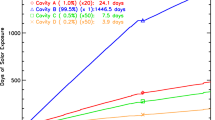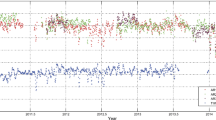Abstract—
Long-term high-precision monitoring of the Earth energy imbalance (EEI) requires new long-term stable space platforms for continuous and representative observation of the entire Earth’s surface over many decades. The Lunar Observatory (LO) is a single system of two special optical robotic twin telescopes with multichannel spectrally separated broad- and narrow-band spectrobolometers positioned along the equator on opposite edges of the Moon. The twin telescopes of the system operate successively in automatic mode as a single telescope, follow a single scientific program, and provide long-term monitoring of the EEI in the spectrum of the Earth’s own thermal radiation (4–50 µm) and Bond albedo in the spectrum of solar radiation (0.2–4 µm), as well as in the bands of 8–13 µm of the atmospheric transparency window (in order to estimate the greenhouse gas contribution) and 0.3–3 µm under ideal nighttime conditions continuously for over 94% of the lunar day with an error of ≈0.1%. These data will make it possible to calibrate the dependence of the average annual EEI value on cyclic variations of the total solar irradiance (TSI), which is a reliable indicator for the reconstruction of EEI changes for the entire period of TSI space measurements since 1978. For the first time, this will make it possible to reliably reveal the physical mechanisms of formation as well as the reasons and regularities of variations of climate for the period of more than 70 years and develop the most reliable methods of its forecasting.






Similar content being viewed by others
REFERENCES
Abdussamatov, H. I., Long-term variations of the integral radiation flux and possible temperature changes in the Solar core, Kinemat. Phys. Celest. Bodies., 2005, vol. 21, no. 6, pp. 328–332.
Abdussamatov, H.I., Current long-term negative average annual energy balance of the Earth leads to the new Little Ice Age, Therm. Sci., 2015, vol. 19, no. Suppl. 2, pp. S279–S288.
Abdussamatov, H.I., Lunar observatory for the study of the deviation of the Earth’s energy balance from the equilibrium state and the causes of climate change, Issled. Zemli iz Kosmosa, 2016, no. 5, pp. 79-88.
Abdussamatov, H.I., Comparative analysis of errors in monitoring the Earth’s global energy budget by the lunar observatory and orbiters, Izv., Atmos. Ocean. Phys., 2018, vol. 54, no. 9, pp. 1341–1352.
Abdussamatov, H.I., Study of the energy imbalance of the Earth and climate from the lunar surface, in Trudy Vserossiiskoi ezhegodnoi konferentsii po fizike Solntsa “Solnechnaya i solnechno–zemnaya fizika-2021” (Proceedings of the All-Russian Annual Conference on Solar Physics “Solar and Solar–Terrestrial Physics-2021), GAO RAN, St. Petersburg, 2021, pp. 3–6.
Abdussamatov, H.I., On the incorrectness of the Gnevyshev-Ohl rule combining even-odd 11-year cycles of the solar activity in physical pairs and on the maxima of XXV and XXVI cycles, Astronomy Reports, 2022, vol. 66, no. 8, pp. 701–709.
CLARREO, Climate absolute radiance and refractivity observatory, CLARREO Pathfinder, 2017. https://clarreo-pathfinder.larc.nasa.gov.
Climate Doctrine of the Russian Federation, order no. 861-rp adopted by the President of the Russian Federation on December 17, 2009.
Harries, J.E., Russell, J.E., Hanafin, J.A., et al., The geostationary Earth radiation budget (GERB) project, Bull. Am. Meteorol. Soc., 2005, vol. 86, no. 7, pp. 945–960.
Loeb, N.G., Wielicki, B.A., Doelling, D.R., et al., Toward optimal closure of the Earth’s top-of-atmosphere radiation budget, J. Clim., 2009, vol. 22, no. 3, pp. 748–766.
Trenberth, K.E., Fasullo, J.T., and Kiehl, J., Earth’s global energy budget, Bull. Am. Meteorol. Soc., 2009, vol. 90, no. 3, pp. 311–323.
Trimble V., Aschwanden M. J., Hansen C. J., Astrophysics in 2006, Space Science Reviews, 2007, vol. 132, pp. 1-182.
Wang, J., Meng, X.M., Han, X.H., et al., 18-months operation of lunar-based ultraviolet telescope: A highly stable photometric performance, Astrophys. Space Sci., 2015, vol. 360, pp. 1–5.
Wielicki, B.A., Barkstrom, B.R., Harrison, E.F., et al., Clouds and the Earth’s radiant energy system (CERES): An Earth observing system experiment, Bull. Am. Meteorol. Soc., 1996, vol. 77, pp. 853–868.
Wielicki, B.A. Young, D.F., Mlynczak, M.G., et al., Achieving climate change absolute accuracy in orbit, Bull. Am. Meteorol. Soc., 2013, vol. 94, no. 10, pp. 1519–1539.
ACKNOWLEDGMENTS
We thank A.A. Garbul for the conducted calculation of the SOTR-300V optical system and P.A. Prokopov for their help in preparing some drawings.
Author information
Authors and Affiliations
Corresponding author
Ethics declarations
The authors declares that he has no conflicts of interest.
Additional information
Translated by O. Pismenov
Rights and permissions
About this article
Cite this article
Abdussamatov, H.I. Study of Climate from the Lunar Surface and the Energy Imbalance between the Earth and Space. Geomagn. Aeron. 62, 952–959 (2022). https://doi.org/10.1134/S0016793222070027
Received:
Revised:
Accepted:
Published:
Issue Date:
DOI: https://doi.org/10.1134/S0016793222070027




